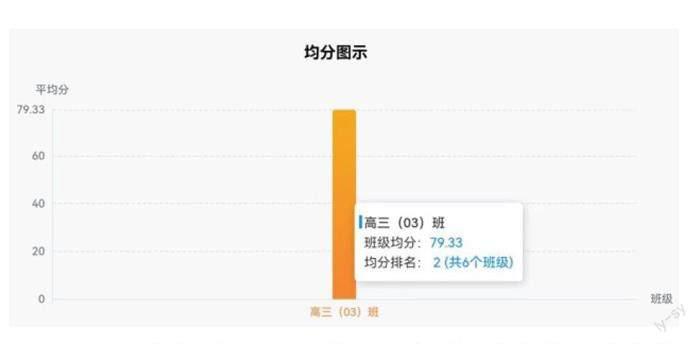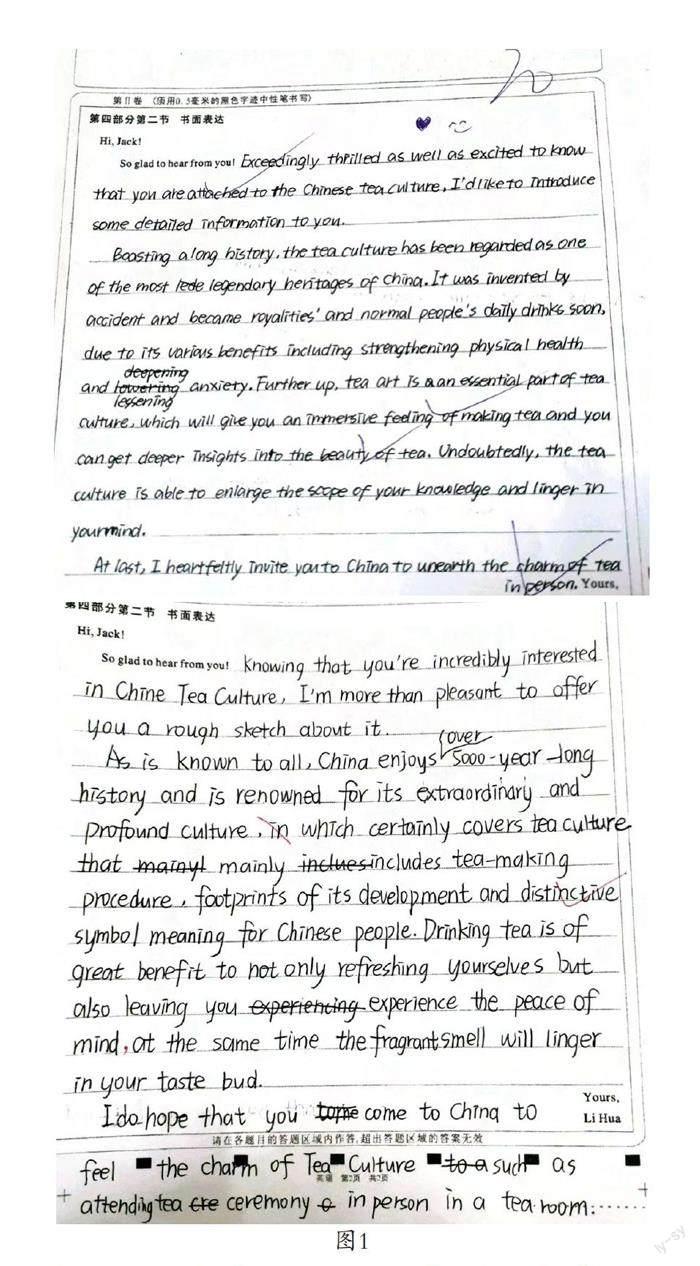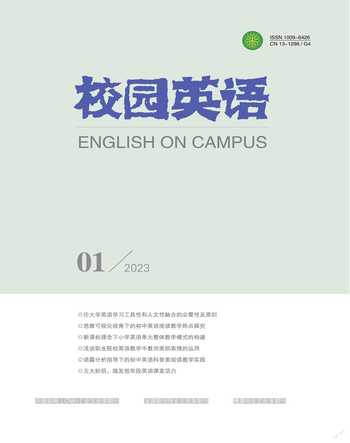高三英语写作教学培养学生文化自信的实践探究
2023-06-20郝婷婷



摘 要:近年的高考英語试题中融入了有关中华优秀传统文化的内容,宣传介绍中国经济、社会和文化发展,这成为高考英语试题改革的重要方向。写作教学是培养学生文化自信,落实立德树人根本任务的有效途径。本文对高三英语写作教学中的典型案例进行分析,引领学生深度思考,坚定文化自信,树立人类命运共同体意识,学会做人做事,成长为有文明素养和社会责任感的人。
关键词:文化知识;写作教学;案例分析
作者简介:郝婷婷,甘肃省陇南市第一中学。
一、背景
《普通高中英语课程标准(2017年版2020年修订)》将文化意识列为英语学科核心素养之一,并对文化意识进行了较为详细的描述。新课标提出了培养和发展学生的学科核心素养,丰富了英语课程的内涵,使英语课程从单一的语言技能训练提升到培养“全面发展的人”的高度。文化意识体现了英语学科核心素养的价值导向,培养学生的文化意识有利于将立德树人根本任务落到实处。因此,培养学生的文化自信是新时代赋予我们英语教师的一项重要的任务。
二、文化知识的内涵
文化知识包含中外文化知识,是学生在语言学习活动中理解文化内涵、比较文化异同、汲取文化精华、坚定文化自信的基础。文化知识涵盖物质和精神两个方面。物质方面主要包括饮食、服饰、建筑、交通等,以及相关的发明与创造;精神方面主要包括哲学、科学、教育、历史、文学、艺术,也包括价值观念、道德修养、审美情趣、社会规约和风俗习惯等。学习中外优秀文化,有助于学生在对不同文化的比较、鉴赏、批判和反思的过程中,拓宽国际视野,理解和包容不同文化,增强对中华优秀传统文化、革命文化和社会主义先进文化的认识,形成正确的价值观和道德情感,成为有文明素养和社会责任感的人。
三、教学案例
首先,在日常教学活动中,根据日常训练和考试要求,灵活增加文化知识的板块,把教学内容与文化知识巧妙地结合在一起。教师发放有关中华优秀传统文化的学习材料,让学生熟悉并能运用其中的核心内容。其次,每次周考、月考和统考后,将写作任务进行归类,帮助学生总结不同文化主题的特色,展示优秀习作,让学生在欣赏美文的同时积累相关的文化知识。学生也通过日常的写作训练巩固了所学的中华文化的相关表述,能够灵活使用不同语言表达相同含义,感悟语言和文化的密切关系,实现了文化的兼容并包,对于中华文化的认同感也在比较中进一步提升。
典型案例一:
书法是中国的一门独特的艺术,是线条的艺术。中国书法就像太极拳,在茫茫虚空中,舞出了一条流动的线。中国书法充满了活力和动感,表现了世界万物的生机活趣。为了让学生们用英语传播中国的书法艺术,笔者发放了“Flying strokes of calligraphy”的阅读材料,以下是部分内容:
Calligraphy is the art of lines, or strokes. In the Tang Dynasty(618-907), the master calligrapher Zhang Xu (birth and death dates unknown) became absorbed all day long in his world of running-cursive script, copying the master calligraphers from former dynasties, but making little progress. One day, on the streets of Chang'an, the capital city of the dynasty, he saw a crowd of people gathering to enjoy a performance by Lady Gongsun, a famous dancer of the time. She was performing a sword dance, her supple body and flying robe mixing with the movements of the sword up and down, and becoming perfectly integrated into the surroundings. Zhang Xu was enchanted, and it was through this performance that he discovered the genuine beauty of calligraphy and made rapid progress in his profession.
The evolution of Chinese calligraphy has benefited from two factors: one is the square-shaped pictographic characters,whose beautiful forms provided preliminary conditions for the art of calligraphy;and the other is the writing brush,an important invention in the history of Chinese culture and the basis for calligraphy to germinate and develop.The writing brush,made from either rabbit,sheep or wolf hair, feels soft, supple, and is elastic and highly ductile. It paved the way for the emergence of the art of calligraphy.
The“one-stroke character”was first advocated by Wang Xianzhi(344-386),son of the most famous calligrapher,Wang Xizhi (303-361) of the Eastern Jin Dynasty (317-420).Wang Xianzhi's Yatou Wan, a masterpiece surviving to this day,was thus written at one go,with a rhythmical line of vital energy only intermittently broken.When appreciating such an artistic work,viewers are always deeply impressed and inspired by its inner lines,without even being conscious of it.
Chinese calligraphy is set against the brushwork of the“ink pig.”The so-called ink pig refers to calligraphic work in heavy,dense ink,which fails to give play to vigorous brushwork,resulting in fat strokes and cumber some handwriting resembling a fat pig.This is exactly due to the lack of vigorous lines and internal energy.
2022年3月24日,高三年级举行了第六次月考。月考试卷中出现了这样一道作文题目:
假定你是李华,你的英国笔友Frank非常喜爱中国的书法。最近他给你写信想了解中国书法的现状,请你给他写一封回信,要点如下:
分析书法的现状;书法的重要性。
通过之前对书法的学习和了解,学生已经学会了使用英语简述中国的书法艺术,以书信的形式宣传和弘扬中华优秀传统文化。因此,笔者所带班级学生的英语作文都取得了比较理想的成绩,高三(3)班的进步最为明显。作文的全年级平均分是12.87分,高三(3)班的平均分是15.04分。本次月考高三(3)版的英语科目平均分79.33排名全年级文科第二,仅次于文科直播班的成绩。考情分析见下图:
\
从以上数据可以看出,学生不仅学习并掌握了中华优秀传统文化及其内涵,对于中华文化的自豪感也进一步提升,文化自信进一步坚定。
典型案例二:
茶是中国人对世界的重要贡献。四千多年前,中国人就有了饮茶的习惯。茶与我们的生活密切相关。饮茶,不仅是身体的需要,也是精神的需要。我们通过饮茶来感悟生命,凈化心灵。2018年高考英语北京卷设置了带领外国友人体验中国茶文化的写作题目。于是笔者给学生印发了茶文化的相关资料。以下是材料的部分内容:
Just as many important events took place in cafes in the West, it is in the tea houses that many important things happened in China. Tea-houses have always been an important setting in the life of the Chinese people.
The most important feature is that of “paying respect.” The Chinese people have long fostered the custom of expressing respect by presenting a cup of tea.They treat guests with tea as a sign of respect,regardless of whether they are thirsty or not,and guests drinking the tea feel refreshed and energized.Educated people treat their guests arriving at night with tea instead of wine, a practice highly appreciated by the literati.In some places in China,there is the custom of presenting tea three times to the guests,as a sign of welcome,then of hospitality,and finally for good wishes.Presenting tea to guests demonstrates not only hospitality but also one's respect for the guests.
The Chinese people look to tea drinking as an art, which incorporates a wide range of knowledge; the taste of tea might be light, yet the meaning is rich and deep. The Chinese attach great importance to the water, tea leaves, tea set, and fire, when making and drinking tea.
Drinking tea is to satisfy the needs of the body as well as the mind. A cup of refreshing tea is able to naturally relieve a person of thirst while giving comfort and pleasure. According to traditional Chinese medicine, drinking tea can cure a variety of diseases, because the slightly bitter and astringent tea contains elements salutary for the body. This has been proven by modern medicine. Chinese people are fond of tea because it helps to satisfy their physical and more spiritual needs. The Chinese also use tea to express respect, to purify the mind, and to better perceive the meaning of life.
在练习成都七中“一诊”考试题的时候,遇到了这样的作文题目:
假定你是李华,你的美国朋友Jack发来邮件,想了解中国的茶文化常识。现在,请你给他回邮件,内容包括:
中国茶文化简介;
饮茶的好处;
邀请他来中国体验茶文化。
注意:1. 词数100左右;
2. 邮件的开头和结尾已为你写好,不计入总词数;
3. 可适当增加细节,以使行文连贯。
Hi, Jack!
So glad to hear from you!
Yours,
Li Hua
通过之前对“茶圣”陆羽、《茶经》以及茶文化的学习和了解,学生们学会了使用英语简述我国的茶文化和饮茶的好处,写作素养和技能也得到了整体提高。图1展示了部分优秀作文。
四、反思
工欲善其事,必先利其器。强化训练不仅可以增强学生的解题能力,而且能提升学生的文化自信和民族自豪感。实践证明,通过认真学习中华优秀传统文化,学生在写作时有话可说,写的内容有真情实感,抒发了自己对于国家与民族的自豪之情。教学中,我们倡导学生们在英语学习中树立胸怀全局、无私分享、共同提高的高尚情怀。学生们笃志力行,形成了团队学习的良性学习氛围。笔者所教两个班级在高考中均取得了不错的成绩,实现了文化浸润、赢得高考的目标。但是,高中英语教学中采用的教材多强调对英语语言知识和英美国家文化的介绍,中国传统文化主题内容涉及较少。因此,增强学生文化自信这一重要任务,需要英语教师不断探究与实践!
参考文献:
[1]程晓堂.基于主题意义探究的英语教学理念与实践[J].中小学外语教学(中学篇),2018(10):1-7.
[2]高洪德.文化品格目标:英语课程的新发展[J].英语学习,2017(1):6-9.
[3]郭颖,张金秀,徐国辉.基于主题意义探究的高中英语阅读教学实践例析[J].中小学外语教学(中學篇),2019(2):1-6.
[4]教育部.普通高中英语课程标准(2017年版2020年修订)[S].北京人民教育出版社,2020.
[5]刘道义,郑旺全,张献臣.立足国情,继往开来,编写具有中国特色的英语教材:谈人教版高中《英语》新教材的编写思路及内容创新[J].英语学习,2019(5):10-15.
[6]卢洪艳,钟志贤.关联主义视域下的个人知识管理[J].远程教育杂志,2012(2):51-56.
